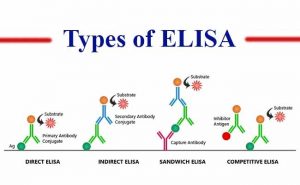Sample Preparation Method for Abbkine Specialized EliKine™ ELISA Kit
The enzyme-linked immunosorbent assay (ELISA) is an immunological assay commonly used to measure antibodies, antigens, proteins and glycoproteins in biological samples. Some examples include: diagnosis of HIV infection, pregnancy tests, and measurement of cytokines or soluble receptors in cell supernatant or serum. The ELISA principle can be categorized into sandwich ELISA, competitive ELISA and indirect ELISA.

(Picture Source: https://microbenotes.com/enzyme-linked-immunosorbent-assay-elisa/ )
Abbkine supplies more than 7000+ ELISA Kits, and EliKine™ ELISA Kit is the most eye-catching part among it. We have clarified the sample preparation method for different samples as below for your convenient use.
A.Serum
Use a serum separator tube and allow samples to clot for two hours at room temperature or overnight at 4 °C before centrifugation for 20 minutes at approximately 1000×g. Assay freshly prepared serum immediately or store samples in aliquot at -20 °C or -80 °C for later use. Avoid repeated freeze/thaw cycles.
B.Plasma
Collect plasma using EDTA or heparin as an anticoagulant. Centrifuge samples for 15 minutes at 1000×g at 2-8 °C within 30 minutes of collection. Remove plasma and assay immediately or store samples in aliquot at -20 °C or -80 °C for later use. Avoid repeated freeze/thaw cycles.
(Note: Samples should be centrifugated adequately and no hemolysis or granule was allowed)
C.Tissue homogenates
- Please choose fresh samples
- The weight of the sample is not less than 50mg, generally 1g, but it is not strictly required that each weight of the sample must reach the same level
- The proportion of homogenate was selected to be 10%, which is equivalent to 1g of tissue and 9ml of homogenization buffer. The component of homogenization buffer: PBS(PH=7.2-7.4,concentration: 0.01mol/L)
- Tissue pieces should be minced to small pieces which will be homogenized with a glass homogenizer on ice. (or using liquid nitrogen to milling)
- The homogenates are then centrifugated for 15 minutes at 5000×g to collect the supernate.
D.Cell culture supernatants
Centrifuge samples for 20 minutes at 1000×g. Remove particulates and assay immediately or store samples in aliquot at -20 °C or -80 °C for later use. Avoid repeated freeze/thaw cycles.
E.Cell lysate
- Digest adherent cells with trypsin, and collect cells by centrifugation (suspended cells can be directly collected by centrifugation);
- Wash cells 3 times with cold PBS;
- Physical method to break the cells (You can also use Ultrasonic breaking first, then freezing and thawing):
- ⇒ Ultrasonic breaking: Resuspend cells in propriate amount of PBS, and break cells with suitable ultrasound;
- ⇒ Repeat freezing and thawing: Freeze cells below -20 degrees, thaw at room temperature, repeat 3 times;
- Centrifuge the sample at 1500 × g at 2-8 degrees for 10 minutes and collect the supernatant for later detection.
(Note: The quantity of cells shall be about 1×106)
If you need to use cell lysis buffer, please set one negative control (cell lysis buffer ) to deduct background value. Be careful not to contain protein denaturants in lysis buffer, like SDS, it may affect the binding between antigens and antibodies. Suggested protocol as below;
Transfer the cell lysate to a centrifuge tube, centrifuge at 1,500 rpm for 10 minutes at 4 °C. Collect supernatant for detection.
F.Urine
Use a sterile tube to collect samples and centrifuge samples for 20 minutes at 2000×g - 3000×g. Thoroughly collect supernatants and assay immediately or store samples in aliquot at 4°C (1 week), -20°C(1 month) or -80 °C(2 month) for later use. Avoid repeated freeze/thaw cycles. If there are sediment during storage, please centrifuge again. (Note:Samples should be should be equilibrated to room temperature before use, don’t heat to dissolve.)
G.Saliva
Collect a certain volume of saliva, then using PBS to dilute it at 1:1 ratio, for example, using 0.1ml saliva to mix with 0.1ml PBS, assay immediately or store samples in aliquot at -20 °C or -80 °C for later use. Avoid repeated freeze/thaw cycles.
Note: The concentration of PBS selected shall be 0.01mol, and PH is between 7.2-7.4.
H.Stool
- Please choose fresh samples
- The weight of the sample is not less than 50mg, generally 1g, but it is not strictly required that each weight of the sample must reach the same level
- The proportion of homogenate was selected to be 10%, which is equivalent to 1g of tissue and 9ml of homogenization buffer. The component of homogenization buffer: PBS(PH=7.2-7.4,concentration: 0.01mol/L)
- Tissue pieces should be minced to small pieces which will be homogenized with a glass homogenizer on ice. (or using liquid nitrogen to milling)
- The homogenates are then centrifugated for 15 minutes at 5000×g to collect the supernate.
I.Milk
- Liquid: Collect 10ml milk, centrifuge samples for 15 minutes at 4000×g, use the middle layer for testing
- Powder: Dilute it at 1:4 ratio, centrifuge samples for 15 minutes at 4000×g. (Use PBS for dilution(PH=7.2-7.4, 0.01mol/L concentration)
For the other types of sample inquiry, please email support@abbkine.com, our technical specialist will come back to you shortly.
| CAT# | Product Name | Detection Range | Price |
| KET6004 | EliKine™ Human CRP ELISA Kit | 15.6 pg/mL-1000 pg/mL | $289/96T |
| KET6017 | EliKine™ Human IL-6 ELISA Kit | 3.125 pg/ml-200 pg/ml | $289/96T |
| KET6032 | EliKine™ Human TNF-α ELISA Kit | 7.8 pg/ml-500 pg/ml | $289/96T |
| KET7009 | EliKine™ Mouse IL-6 ELISA Kit | 7.82 pg/mL-500 pg/mL | $289/96T |
| KET7015 | EliKine™ Mouse TNF-α ELISA Kit | 15.6 pg/ml-1000 pg/ml | $289/96T |
| KET0001 | EliKine™ Testosterone ELISA Kit | 0.1 ng/ml-20 ng/ml | $289/96T |
| KET9001 | EliKine™ Rat IL-1β ELISA Kit | 62.5 pg/ml-4000 pg/ml | $289/96T |

Abbkine Scientific’s position: Serve the worldwide customers who do cytology and proteomics research, providing both economical and technical product solution in the manner of application process and product combination.











